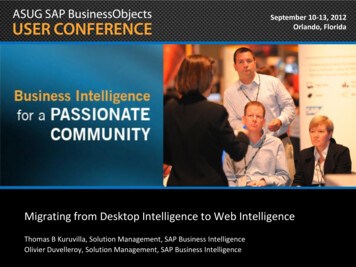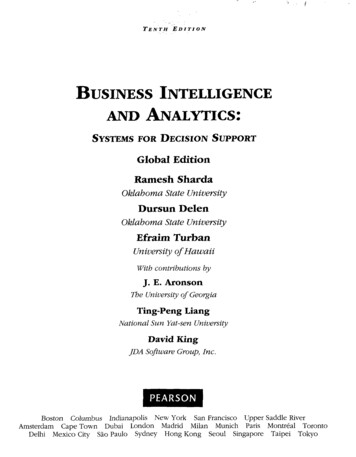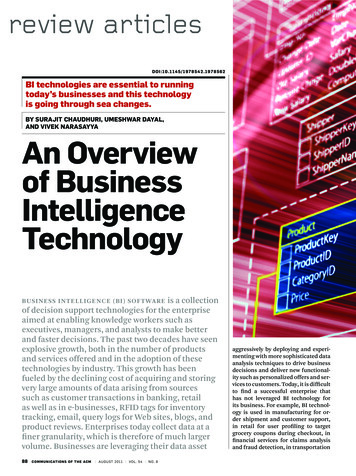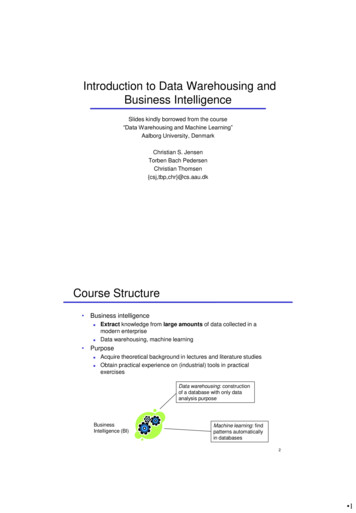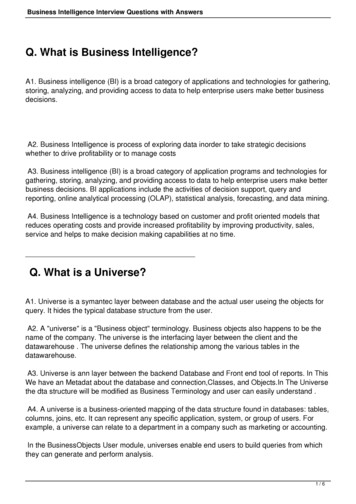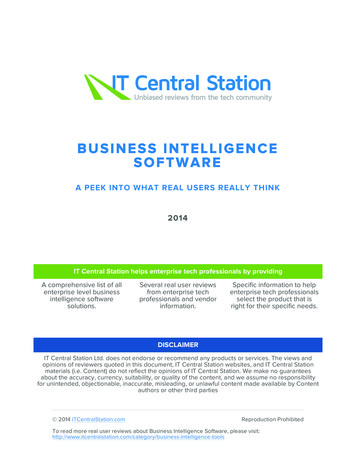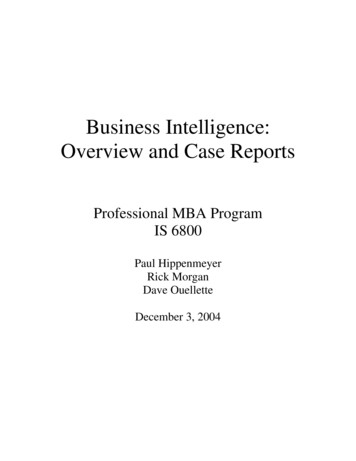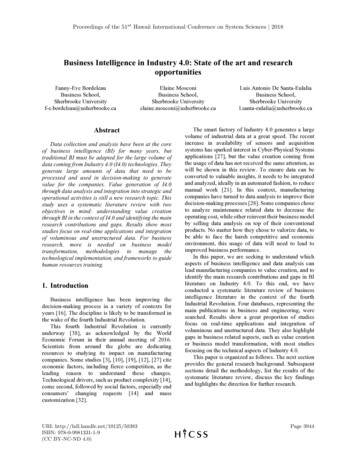
Transcription
Proceedings of the 51st Hawaii International Conference on System Sciences 2018Business Intelligence in Industry 4.0: State of the art and researchopportunitiesFanny-Eve BordeleauBusiness School,Sherbrooke Universityf-e.bordeleau@usherbrooke.caElaine MosconiBusiness School,Sherbrooke a collection and analysis have been at the coreof business intelligence (BI) for many years, buttraditional BI must be adapted for the large volume ofdata coming from Industry 4.0 (I4.0) technologies. Theygenerate large amounts of data that need to beprocessed and used in decision-making to generatevalue for the companies. Value generation of I4.0through data analysis and integration into strategic andoperational activities is still a new research topic. Thisstudy uses a systematic literature review with twoobjectives in mind: understanding value creationthrough BI in the context of I4.0 and identifying the mainresearch contributions and gaps. Results show moststudies focus on real-time applications and integrationof voluminous and unstructured data. For businessresearch, more is needed on business modeltransformation, methodologies to manage thetechnological implementation, and frameworks to guidehuman resources training.1. IntroductionBusiness intelligence has been improving thedecision-making process in a variety of contexts foryears [16]. The discipline is likely to be transformed inthe wake of the fourth Industrial Revolution.This fourth Industrial Revolution is currentlyunderway [38], as acknowledged by the WorldEconomic Forum in their annual meeting of 2016.Scientists from around the globe are dedicatingresources to studying its impact on manufacturingcompanies. Some studies [3], [10], [19], [12], [27] citeeconomic factors, including fierce competition, as theleading reason to understand these changes.Technological drivers, such as product complexity [14],come second, followed by social factors, especially endconsumers’ changing requests [14] and masscustomization [32].URI: http://hdl.handle.net/10125/50383ISBN: 978-0-9981331-1-9(CC BY-NC-ND 4.0)Luis Antonio De Santa-EulaliaBusiness School,Sherbrooke Universityl.santa-eulalia@usherbrooke.caThe smart factory of Industry 4.0 generates a largevolume of industrial data at a great speed. The recentincrease in availability of sensors and acquisitionsystems has sparked interest in Cyber-Physical Systemsapplications [27], but the value creation coming fromthe usage of data has not received the same attention, aswill be shown in this review. To ensure data can beconverted to valuable insights, it needs to be integratedand analyzed, ideally in an automated fashion, to reducemanual work [21]. In this context, manufacturingcompanies have turned to data analysis to improve theirdecision-making processes [28]. Some companies choseto analyze maintenance related data to decrease theoperating cost, while other reinvent their business modelby selling data analysis on top of their conventionalproducts. No matter how they chose to valorize data, tobe able to face the harsh competitive and economicenvironment, this usage of data will need to lead toimproved business performance.In this paper, we are seeking to understand whichaspects of business intelligence and data analysis canlead manufacturing companies to value creation, and toidentify the main research contributions and gaps in BIliterature on Industry 4.0. To this end, we haveconducted a systematic literature review of businessintelligence literature in the context of the fourthIndustrial Revolution. Four databases, representing themain publications in business and engineering, weresearched. Results show a great proportion of studiesfocus on real-time applications and integration ofvoluminous and unstructured data. They also highlightgaps in business related aspects, such as value creationor business model transformation, with most studiesfocusing on the technical aspects of Industry 4.0.This paper is organized as follows. The next sectionprovides the general research background. Subsequentsections detail the methodology, list the results of thesystematic literature review, discuss the key findingsand highlights the direction for further research.Page 3944
2. Research background2.1. Business intelligenceBusiness intelligence (BI) is a broad conceptincluding the collection, integration, analysis andvisualization of organizational data to support andimprove the decision-making process [16]. The phasesof a BI initiative adapted from Eckerson [13] arepresented in Figure 1. First, data is collected. Then, it isextracted, transformed and loaded (ETL) into themultidimensional database, usually a Data Warehouse,where it can be analyzed and presented [13]. Datapresentation includes reports and interactive datadiscovery [21], alerts and operational graphical userinterface [14] or dashboards [20],[21]. These phases relyon a technical architecture, often including a datawarehouse.Technological ionFigure 1. Phases of BI, adapted from Eckerson (2011)The benefits of BI are mostly indirect. BI contributesto fact-based decision-making and helps improve thequality of information [16]. These improved decisionsbased on quality information then lead to enhancedbusiness performance. On the other end, thetechnological improvements and new Cyber-PhysicalSystems offer new BI capabilities, such as predictiveand adaptive indicators [3] which were not previouslymeasurable. They can also facilitate and reduce the costof real-time operational dashboards [14], a technologypreviously available but complex and cost-prohibitive.2.2. BI operational and strategic value creationBI can be used at any hierarchical level in thecompany: strategic, tactical or operational [13]. Thispaper will focus on the strategic and operational levels,leaving aside the tactical level which can sometimes beharder to distinguish from the other two. At theoperational level, BI serves workers by monitoringprocesses [13], often with the help of performanceindicators. At the strategic level, executives monitor,manage, and analyze business performance inaccordance with the strategic objectives [13]. Strategicobjectives supported by BI include new marketdevelopment, major manufacturing technologicalinvestments or modifications to business models.Operational and strategic value are captured differently.Fink et al. (2017) state that “operational value representsimprovements in the efficiency of business process [ ]whereas strategic value represents the ability to meetorganizational objectives” (p.44). Manufacturingapplications of BI, sometimes referred to asManufacturing Intelligence [21], are often moreoperational in nature since they aim at improving floorplant decisions. Real time monitoring and analysis aretwo of the most popular applications, but this does notnegate the use of operational information to improvebusiness decision on a strategic level, such ascompetition related questions.Operational BI capabilities are strongly related tooperational value creation, but also lead to strategicvalue creation [16]. Thus, companies should dedicateresources to measuring strategic value even when onlyoperational BI applications are implemented. Thismeasure will contribute to situation awareness withrespect to the execution of the business plan, andfacilitate the business’s transition into Industry 4.0.2.3. Industry 4.0 and the Smart FactoryIndustry 4.0 is a concept introduced by the Germangovernment to lead manufacturing companies into thefourth Industrial Revolution [28]. The core technologiesof Industry 4.0 include sensors, communicationprotocols, cloud computing, cyber-physical systems,additive manufacturing, business intelligence and bigdata, and other emerging technologies. Most of thesetechnologies are not recent innovations. However, it isthe combination of technologies, business processes,and data processing that makes Industry 4.0 a novelty[2]. Schwab [38] expressed the need to understand howthe fourth Industrial Revolution will reshape the“economic, social, cultural and human context in whichwe live” (p.2). Value creation for organizations will beachieved through innovative products and services,increased competitiveness and improved operationalprocesses [2]. Although Industry 4.0 is only one of manygovernments led initiatives to guide companies throughthe current revolution, this paper uses it as a guidelinebecause of the prevalence of the term in academicliterature. Possible synonyms include smartmanufacturing, the industrial internet and the smartfactory.Industry 4.0 manifests itself in many ways, the mostprominent being the smart factory. A smart factoryintegrates autonomous computing and machine-tomachine communication to achieve a state of selfawareness and create self-learning machines [28]. Thisallows for better control of manufacturing processes,such as monitoring the remaining useful life of tools andequipment, increased uptime and better product quality[3], providing we can collect, analyze and use the data.Page 3945
2.4. Reference Architecture: RAMI 4.0Since Industry 4.0 is a new concept, there is a needto develop a shared language and a structuredframework. The Reference Architectural Model ofIndustry 4.0 (RAMI 4.0) is a three-dimensional modeldeveloped by a consortium led by the Association ofGerman Engineers (VDI) and German Electrical andElectronic Manufacturers’ Association (ZVEI) [1]. It isintended to assemble Industry 4.0 related standards.Figure 2 below is reproduced from Adolphs and Epple[1]. The cube is meant to represent horizontalintegration of data in the value stream and verticalintegration through an enterprise’s hierarchical levels:product, field device, control devices, station, workcenter, enterprise, and the connected world.Hierarchy levelsLayersLife cycle and value tegrationAssetFigure 2. RAMI 4.0 adapted from Adolphs & Epple(2017)The layers are meant as a reminder to integrate allaspects of the enterprise in the digitalization, not onlycommunication and information. For instance, asuccessful business intelligence application like a teamleader’s dashboard must integrate and compute datacoming from assets such as equipment’s sensors,communicate it to the dashboard and meet therequirements of the business layer, namely thebusiness’s senior management.3. Research MethodTo minimize bias in the selection of the articlesincluded in this study, a systematic methodology wasSubjectResearchquestionsDatesDatabanksSearch criteriaInclusion criteriaKeywords (I4.0)Keywords (BI)adopted. A systematic review is a transparent andreproducible search of the existing literature, in whichgreat care is taken to apply objective criteria to theinclusion or rejection of an article [41]. Transparencyand reproducibility is ensured by following theguidelines proposed by Tranfield, Denyer and Smart[41]. These guidelines consist of nine phases divided inthree stages, as presented in Table 1.Table 1. Stages of a systematic review, adapted fromTranfield et al. [41]Stage Phase1. Planning the review0. Identification of the need for a review1. Preparation of a proposal2. Development of review protocol2. Conducting the review3. Identification of studies4. Selection of studies5. Study quality assessment6. Data extraction7. Data synthesis3. Reporting results8. Report and recommendations9. Getting evidence into practice3.1. Planning the reviewAs previously mentioned in this paper, Industry 4.0is still a relatively new subject in academic literature andthere are gaps in business intelligence research on thesubject. Thus, there is a need to grasp what has beeninvestigated and what remains to be studied. We areespecially interested in existing studies’ mentions ofvalue creation, operational and strategic. Whiledeveloping the review proposal, the existing literaturewas searched. No other literature review on BI andIndustry 4.0 was available at this time. The reviewprotocol [41] included identification of the researchquestion, the search criteria including dates anddatabanks to be searched, and the inclusion criteria. Theprotocol summary is presented in Table 2. More detailsare given in the following section.Table 2. Review protocol summaryBusiness intelligence in manufacturing in Industry 4.0What are the gaps and research opportunities in business intelligence regarding Industry 4.0 formanufacturing? Which aspects of business intelligence and data analysis can lead manufacturingcompanies to value creation?from 2010 to extraction date (February 2017)ABI/Inform, Business Search Complete, ScienceDirect, ScopusPeer reviewed; Full text included; English; Title, abstract and keywords OR All (except full text).Discusses at least one manufacturing activity in the following list: matter transformation, equipmentmaintenance, plant warehouse management or explicit mention of manufacturing AND Discusses at leastone BI subject in the following list: decision making process or decision support (including data acquisition and storage), data quality, information display, performance monitoring, analytic or data analysis.Industry 4.0, Industrie 4.0, Smart factory, Manufacturing intelligence, Industrial internet.Business intelligence, BI, Analytics, Data analysis, Data science, Monitoring, Surveillance, MES,Manufacturing execution system, SCADA, Supervisory Control and Data Acquisition.Page 3946
3.2. Conducting the reviewThe objective of this review is to identify studies thatwere conducted in the field, and determine any gaps andopportunities in business intelligence research inIndustry 4.0, specifically those related tomanufacturing. It consists of a systematic examinationof peer reviewed and indexed scholarly articles orconference papers published between 2010 and January2017 on the above-mentioned topics. The year 2010 waschosen as the earliest date since the Industry 4.0 conceptwas defined in Germany around 2011. The firstarchitectural reference model for Industry 4.0 waspublished in 2015 [1] and was accepted as a standard byGerman standard association DIN in 2016.The following keywords were used as synonymousfor Industry 4.0: Industry 4.0, Industrie 4.0, smartfactory, manufacturing intelligence, and industrialinternet. The keywords related to business intelligencewere: business intelligence, analytics, data analysis,data science, monitoring, surveillance, MES,manufacturing execution system, SCADA, supervisorycontrol and data acquisition. Four electronic articledatabases were selected because they contain the mainpublications in business intelligence and informationsystems: ABI/Inform, Science Direct, SCOPUS andBusiness Source Complete. Whenever possible, thesearch was limited to the title, abstract or keywords. Ifthis option was not available, the search was set to “allexcept full text”. Only English publications wereincluded.To be included in the sample, the article had tocorrespond to the definition of BI as presented in section2.1, notably the project had to deal with information,and not just raw data. It also had to cover manufacturingoperations, or manufacturing companies. Value creationwas not considered an inclusion criteria since a sub-goalof this study is to determine to what extent the valuecreation is included in the articles.The search yielded 299 publications which wereexported to eliminate duplicates. They were then filteredfirst on abstract reading, and finally for a completereading based on the inclusion criterion mentionedabove. The study quality assessment was made duringthe complete reading. No articles were excluded basedon the quality of the research method. Table 3 presentsthe filtering results, with 42 distinct articles fitting theinclusion criterion. Most of the rejected articles wereexcluded because they were focusing on very technicalaspects, i.e. wireless communication protocol, databasestructure or design of new sensors. They were notconsidered BI research.A backward search was only performed whennecessary to understand the context of an article, andwas not included in the studied publications.Table 3. Articles filtering processFiltering stageArticles countDatabase extract299ABI/Inform:10 Science SCOPUS:BusinessDirect: 44185SourceComplete 60Duplicate removalAbstract readingFull article reading2489742During the reading of the full article, variousinformation on the article’s bibliometrics and contentwas tagged for analysis based on the research design, BIsubject, RAMI4.0 layer, cited performance indicatorsand value creation measures or indicators. The resultsare presented in section 4.4. Results4.1. Bibliometric analysisThe bibliometric analysis is based on five criteria:year of publication, journal or conference, authors,country of the principal author, and research design.The distribution by publication year is detailed inFigure 3. Although the year filter was set to 2010, theearliest relevant articles were published in 2012. This isconsistent with the emergence date of Industry 4.0.Interest in the subject seems to be growing significantly,although it should be noted that, for 2017, only Januarywas included in the study.Figure 3. Distribution by publication yearA significant number of articles were conferenceproceedings. The 42 articles were distributed in 30publication channel, journals or conferences. Threepublication channels had at least three articles: tenarticles were published through one of IEEE’s channels,five were published in the conference proceedings ofCIRP and three in the proceedings of the InternationalFederation of Automatic Control.The Industry 4.0 concept originally comes fromGermany. Unsurprisingly, almost a quarter of theselected articles were published there. However,analysis of the articles by country of the principal authoras illustrated in Figure 4 shows a growing interest in themanufacturing dependent countries of South-East Asia,as well as in the United States.A clear majority of articles presented the creation ofa physical or digital artefact, such as a databasePage 3947
infrastructure or the programming of a dashboard. Someauthors employed a conceptual design, notably inCyber-Physical Systems architecture [27], [3].display on a dashboard, which covers data acquisition,storage, analysis and presentation [24].Figure 5. BI subject distributionFigure 4. Country of the principal author4.2. Content analysisAnalysis of BI and related technological aspectreveals 33 out of 42 articles included real time or nearreal-time data processing. In many of these articles,authors emphasized the technical difficulty ofprocessing machine data in real time, because ofdatabase limitations [5], the integration of unstructureddata [23], limits to the acceptable visual complexity [46]or the number of variables required to develop asufficiently precise model [35], [45].Nearly half of the articles presented data analysisapplications, such as clustering [3],[45] or decision trees[10]. Figure 5 also shows 16 articles suggested atechnological architecture without focusing on a singleBI phase. For example, a technological framework usingreal time employee localization to adjust informationThe classical BI architecture, relying on a datawarehouse, cannot alone process unstructured orvoluminous data in real or near real time [4]. Severalauthors have mentioned using Manufacturing ExecutionSystems (MES) to integrate data coming from differentmachines, devices and products [14], [21], [19] in realtime. Data collected by the MES can then be used to feeddashboards, control cards or statistical algorithms.Only three articles address the specific needs ofSmall and Medium-Sized Enterprises (SME). Thesecompanies often have limited financial andtechnological resources, and adopting a complete BIinfrastructure is beyond their reach [12]. Severalindustrial domains were covered, notably aluminium[6], steel rolling [21] and flat steel [5], autom
2.1. Business intelligence Business intelligence (BI) is a broad concept including the collection, integration, analysis and visualization of organizational data to support and improve the decision-making process [16]. The phases of a BI initiative adapted from Eckerson

